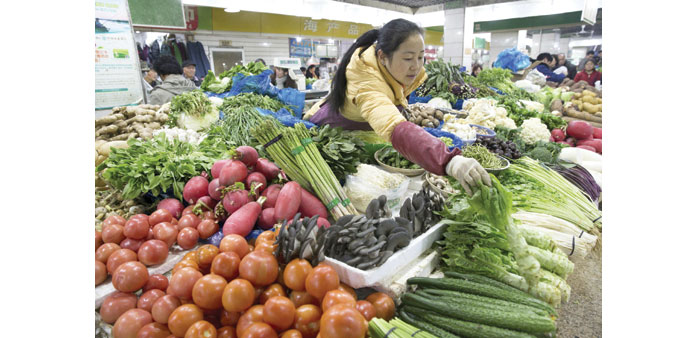A vendor arranges vegetables at her stall at a market in Nanjing. China’s consumer inflation picked up slightly in November rising 1.5% on-year from 1.3% in October.
Reuters
Beijing
China’s consumer inflation picked up slightly in November but remained well under the government’s 2015 price target of 3%, raising concerns that the world’s No 2 economy could be sucked into a Japan-style deflationary trap.
With the economy sputtering after years of double-digit growth, analysts predict Chinese consumer prices are unlikely to pick up significantly in the near future due to crumbling commodity and energy prices, overcapacity and weak demand.
The data has increased calls from some economists for more stimulus and interest rate cuts to spur growth and prices, even though the November consumer price index (CPI) surprised on the upside, rising 1.5% on-year from 1.3% in October. A Reuters poll had tipped a 1.4% rise.
“With corporate confidence already at a six-year low, persistent deflation might also put the economy at risk of a downward spiral,” said HSBC economists in a note to clients.
“More aggressive policy easing still holds the key to stabilise growth in the coming months.”
Wednesday’s release from the National Bureau of Statistics (NBS) also showed factories were plagued by producer price deflation, with the producer price index (PPI) down 5.9% in November from a year earlier, in line with expectations and flat from October’s drop.
It marked the 45th straight month of declines in the index.
NSBO economists in Beijing estimated that inflation-adjusted lending rates are as high as 10.7% when calculated using PPI, seen as inhibiting fresh investment.
On a monthly basis, consumer prices were flat, compared with a 0.3% fall in October.
While entrenched PPI deflation is hurting companies, economists are more concerned about falling consumer inflation, fearing that if prices slip further, China may face a Japanese-style ‘lost decade’. “China has entered a deflationary era,” Liu Li-Gang and Louis Lam, economists at ANZ, wrote in a research note. “More alarmingly, the GDP deflator, a broader measure of price changes in the economy, declined 0.7% y/y in Q3, indicating that China has entered a deflationary era.”
The risk that Chinese consumption might sink is not only a major risk for domestic policy makers but also for foreign firms who have invested heavily on the assumption that Chinese spending would help offset weak demand elsewhere.
There are already signs that China is slowing its purchases of imported wine, which looks to hit profits at wine importers like ASC Fine Wines, owned by Japan’s Suntory Group.
While official retail sales figures have been a rare bright spot in a faltering economy, private sector surveys have shown consumer sentiment plumbing record lows in recent months.
Chinese manufacturing has been stagnating for more than three years, with wholesale prices sliding continuously as legions of small companies compete desperately to stay above water.
November trade data on Tuesday and the recent official Purchasing Managers’ Index (PMI) also underscored the persistent slack in the economy.
In a bid to avert a sharper economic slowdown, China’s central bank has already cut interest rates six times since last November and reduced the amount of cash that banks must set aside as reserves. The government has also eased restrictions on home buying to boost the sluggish property market and is trying to ramp up infrastructure spending.
Economic growth dipped to 6.9% in the third quarter, according to official statistics, dropping below the 7% mark for the first time since the global financial crisis.
HSBC expects both consumer and producer prices to head lower and forecast another 50-basis point policy rate cut and 400-bps reserve ratio cut in 2016.



